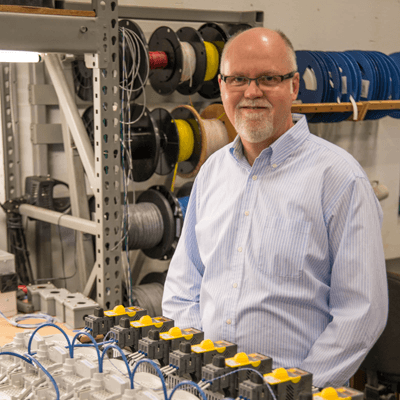“We buy more than half of our components in Washington or Oregon,” said Johnson.
Many components used by AMS are produced all over the world, but are channeled through several local distributors. And, said Johnson, he couldn’t think of a single time when AMS had to go outside the U.S. to buy a specialty component.
“If we go out to buy something special, we look locally first, then across the country,” said Johnson.
Quality & cost
According to Vance, REDpoint’s Versatilt product, a wheelchair tilting device for safe patient handling, was in development for a long time in order to make it be a better product. Having a geographically close manufacturer (located in Tualatin) to converse with made it easier to “come up with best possible solutions.”
While AMS does a lot of their machining and fabricating in-house, they also contract with other manufacturers to produce certain components. Johnson said that working with local businesses improves logistics in several ways.
“We always seem to be on a tight schedule,” said Johnson. “If we need a part machined, it’s good to be close and be able to work with them on quality. Plus, it reduces shipping costs and times.”
Chuck Nokes, vice president of business development for REDpoint, agreed that utilizing local manufacturing resources gives the company “the ability to better control quality and costs.”
For example, shipping costs can reach $1,800 for a single container leaving China for California, according to the shipbroker giant Clarkson PLC. Add in high fuel costs, and offshore manufacturing is no longer dirt cheap.
Bruzzone said that while national, non-local companies may be able to offer a lower bid on initial job cost, business owners should factor in long-term costs, such as trip charges for service calls. For example, he decided to go with a local distributor for soft drinks, instead of a more well-known brand whose distributor was based in Atlanta.
“The Atlanta guy told me to go online, fill out a form, and they’d get back to me in three to five business days,” said Bruzzone. “The local distributor lives right here in Camas. We began designing the system flow that same day.”
Similarly, the cabinet maker who created Bruzzone’s new countertops is located within a mile of the restaurant. Bruzzone said he can literally see his sign-maker’s business from the front door of his restaurant, and his meat supplier is only three minutes away.
“They can be here within minutes to solve a problem,” he added.
Vance concluded that “people work together when they feel you’re part of a community of business. People pull together to see all of us succeed.”
As an example, she related that when REDpoint had an opportunity to gain a government contract but had not yet completed their GSA application, she sent an e-mail to her network of business associates, seeking a like-type of business that would let REDpoint “piggy back” on their GSA number. Six companies responded, and REDpoint was able to land the contract.
“When you work with local suppliers,” said Bruzzone, “everyone cares that you’ll be around next week. That’s a vested interest that you share with each other.”
More emphasis on U.S. manufacturing
Bonnie Moore, director of business growth and innovation for the Columbia River Economic Development Council, said that “in Washington, there’s an effort to highlight companies that make the majority of their goods in the US.”
Moore pointed to Impact Washington’s “Made in Washington” program, which showcases products made in our state. The company currently featured on the organization’s website is Vancouver-based Irrigation Accessories Co. Other local manufacturers emphasizing the fact that their products are made in Washington, said Moore, include Pendleton Woolen Mills, Cadet Manufacturing, Last US Bag, Sigma Design, AIMMCO and First Aid Only.
Other indicators of an increased focus on U.S. manufacturing include the following:
A national “Should Be Made in America” campaign headed by the Alliance for America Manufacturing (AAM), urges the use of American-made components for infrastructure projects financed with U.S. tax dollars.
Wal-Mart’s announcement that it will buy an additional $50 billion in U.S.-made products over the next decade in areas like sporting goods and high-end appliances.
The re-introduction on March 5 of the “Invest in American Jobs Act” (HR 949).
Paul Johnson, chief operations officer at Applied Motion Systems Inc. (AMS), said that although his company works all across the country, with at least half of their business east of the Mississippi, AMS has “added the strategy of trying to grow our business regionally.” This benefits AMS employees by working closer to home, but more importantly, said Johnson, it can help the region be more competitive in manufacturing.
“I believe any kind of resurgence of U.S. manufacturing is going to come through automation,” said Johnson.
For example, he explained, older mechanical machines in a wide variety of industries from bottle making to rolled paper products can benefit from being retrofitted with modern servo control systems such as those produced by AMS.
“By finding and developing regional and local customers,” said Johnson, “we can help them produce more efficiently and more reliably.”
{jathumbnail off}









